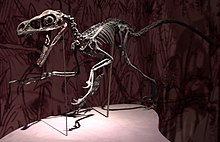
Velociraptor is a genus of small dromaeosaurid dinosaurs that lived in Asia during the Late Cretaceous epoch, about 75 million to 71 million years ago. Two species are currently recognized, although others have been assigned in the past. The type species is V. mongoliensis, named and described in 1924. Fossils of this species have been discovered in the Djadochta Formation, Mongolia. A second species, V. osmolskae, was named in 2008 for skull material from the Bayan Mandahu Formation, China.
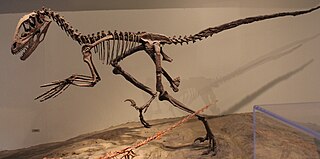
Deinonychus is a genus of dromaeosaurid theropod dinosaur with one described species, Deinonychus antirrhopus. This species, which could grow up to 3.4 meters (11 ft) long, lived during the early Cretaceous Period, about 115–108 million years ago. Fossils have been recovered from the U.S. states of Montana, Utah, Wyoming, and Oklahoma, in rocks of the Cloverly Formation and Antlers Formation, though teeth that may belong to Deinonychus have been found much farther east in Maryland.
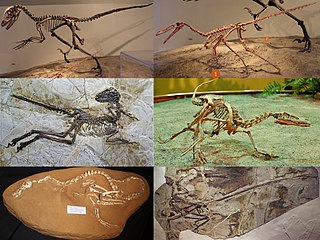
Dromaeosauridae is a family of feathered coelurosaurian theropod dinosaurs. They were generally small to medium-sized feathered carnivores that flourished in the Cretaceous Period. The name Dromaeosauridae means 'running lizards', from Greek δρομαῖος (dromaîos), meaning 'running at full speed', 'swift', and σαῦρος (saûros), meaning 'lizard'. In informal usage, they are often called raptors, a term popularized by the film Jurassic Park; several genera include the term "raptor" directly in their name, and popular culture has come to emphasize their bird-like appearance and speculated bird-like behavior.

Dromaeosaurus is a genus of dromaeosaurid theropod dinosaur that lived during the Late Cretaceous period, sometime between 80 and 69 million years ago, in Alberta, Canada and the western United States. The type species is Dromaeosaurus albertensis, which was described by William Diller Matthew and Barnum Brown in 1922. Its fossils were unearthed in the Dinosaur Park Formation. Teeth attributed to this genus have been found in the Prince Creek Formation. Dromaeosaurus is the type genus of both Dromaeosauridae and Dromaeosaurinae, which include many genera with similar characteristics to Dromaeosaurus such as possibly its closest relative Dakotaraptor. Dromaeosaurus was heavily built, more so than other dromaeosaurs that are similar in size, like Velociraptor.

Sinornithosaurus is a genus of feathered dromaeosaurid dinosaur from the early Cretaceous Period of the Yixian Formation in what is now China. It was the fifth non–avian feathered dinosaur genus discovered by 1999. The original specimen was collected from the Sihetun locality of western Liaoning. It was found in the Jianshangou beds of the Yixian Formation, dated to 124.5 million years ago. Additional specimens have been found in the younger Dawangzhangzi bed, dating to around 122 million years ago.

John Harold Ostrom was an American paleontologist who revolutionized the modern understanding of dinosaurs. Ostrom's work inspired what his pupil Robert T. Bakker has termed a "dinosaur renaissance".
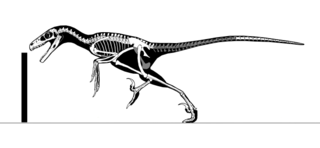
Saurornitholestes is a genus of carnivorous dromaeosaurid theropod dinosaur from the late Cretaceous of Canada (Alberta) and the United States.

Ornitholestes is a small theropod dinosaur of the late Jurassic of Western Laurasia.

Adasaurus is a genus of dromaeosaurid dinosaur that lived in Asia during the Late Cretaceous period about 70 million years ago. The genus is known from two partial specimens found in the Nemegt Formation of Mongolia that were partially described in 1983 by the paleontologist Rinchen Barsbold.

Achillobator is a genus of large dromaeosaurid theropod dinosaur that lived during the Late Cretaceous period about 96 million to 89 million years ago in what is now the Bayan Shireh Formation of Mongolia. The genus is currently monotypic, only including the type species A. giganticus. The first remains were found in 1989 during a Mongolian-Russian field expedition and later described in 1999. Remains at the type locality of Achillobator may represent additional specimens. It represents the first and largest dromaeosaurid known from the Bayan Shireh Formation.

Tenontosaurus is a genus of medium- to large-sized ornithopod dinosaur. It was a relatively medium sized ornithopod, reaching 6.5 to 8 meters in length and 600 to 1,000 kilograms in body mass. It had an unusually long, broad tail, which like its back was stiffened with a network of bony tendons.
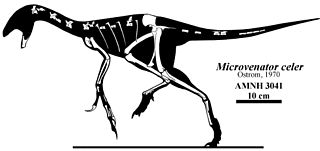
Microvenator is a genus of dinosaur from the Early Cretaceous Cloverly Formation in what is now south central Montana. Microvenator was an oviraptorosaurian theropod. The holotype fossil is an incomplete skeleton, most likely a juvenile with a length of 1.3 m (4.3 ft), and consequently, the adult size remains uncertain. Microvenator celer is primitive and may be the "sister taxon to all other oviraptorosaurs."

Velociraptorinae is a subfamily of the theropod group Dromaeosauridae. The earliest velociraptorines are probably Nuthetes from the United Kingdom, and possibly Deinonychus from North America. However, several indeterminate velociraptorines have also been discovered, dating to the Kimmeridgian stage, in the Late Jurassic Period. These fossils were discovered in the Langenberg quarry, Oker near Goslar, Germany.

Hesperonychus was a small, carnivorous dinosaur. It was a member of the family Dromaeosauridae, along with its larger relatives Deinonychus and Velociraptor. There is one described species, Hesperonychus elizabethae. The type species was named in honor of Dr. Elizabeth Nicholls of the Royal Tyrrell Museum of Palaeontology who collected it as a student in 1982. It is known from fossils recovered from the lowermost strata of the Dinosaur Park Formation of Alberta, dating to the late Cretaceous about 76.5 million years ago. Though known from partial remains, researchers have estimated that it was a small dinosaur measuring about 1 metre (3.3 ft) long and weighing between 1.5 and 2 kilograms, making it the smallest carnivorous non-avian dinosaur known from North America.
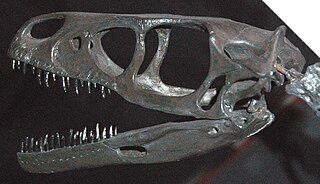
Saurornitholestinae is a subfamily of the theropod group Dromaeosauridae. The saurornitholestines currently include three monotypic genera: Atrociraptor marshalli, Bambiraptor feinbergi, and Saurornitholestes langstoni. All are medium-sized dromaeosaurs from the Late Cretaceous of western North America. The group was originally recognized by Longrich and Currie as the sister taxon to a clade formed by the Dromaeosaurinae and Velociraptorinae. However, not all phylogenetic analyses recover this group and/or with the same proposed genera.

Tianyuraptor is a genus of short-armed dromaeosaurid dinosaur that lived during the Early Cretaceous, about 122 million years ago. Its remains have been found in western Liaoning, China. It was similar to other dromaeosaurids found in Liaoning, with the exception of being somewhat more primitive. The type specimen, formally named in 2009, shows features not seen in previously known Northern Hemisphere (Laurasian) dromaeosaurids, but present in Southern Hemisphere (Gondwanan) species and early birds. Because of this, the scientists who first studied Tianyuraptor described it as a "transitional species", bridging the gap between northern and southern types of dromaeosaurid. Tianyuraptor also differs from previously known dromaeosaurids in that it possesses a relatively small furcula ("wishbone"), and unusually short forelimbs.

This timeline of dromaeosaurid research is a chronological listing of events in the history of paleontology focused on the dromaeosaurids, a group of sickle-clawed, bird-like theropod dinosaurs including animals like Velociraptor. Since the Native Americans of Montana used the sediments of the Cloverly Formation to produce pigments, they may have encountered remains of the dromaeosaurid Deinonychus hundreds of years before these fossils came to the attention of formally trained scientists.

Dakotaraptor is a potentially chimaeric genus of large dromaeosaurid theropod dinosaur that lived in western North America during the Late Cretaceous period. The remains have been found in the Maastrichtian-aged Hell Creek Formation, dated to the very end of the Mesozoic era, making Dakotaraptor one of the last surviving dromaeosaurids. The remains of D. steini were discovered in a multi-species bonebed. Elements of the holotype and referred specimens were later found to belong to trionychid turtles and further analysis of potential non-dromaeosaurid affinities of the holotype and referred material have not yet been conducted. Phylogenetic analyses of D. steini place it in a variety of positions within Dromaeosauridae.

Wulong is a genus of microraptorine dromaeosaurid dinosaurs from the Early Cretaceous (Aptian) Jiufotang Formation of China. The genus includes a single species, Wulong bohaiensis. The skeletal remains, which include preserved feathers, represent a juvenile.

Dineobellator is a genus of dromaeosaurid theropod dinosaur that lived in North America during the Late Cretaceous period 68 million years ago. The remains have been found in the Maastrichtian stage of the Naashoibito Member at the Ojo Alamo Formation, New Mexico.
